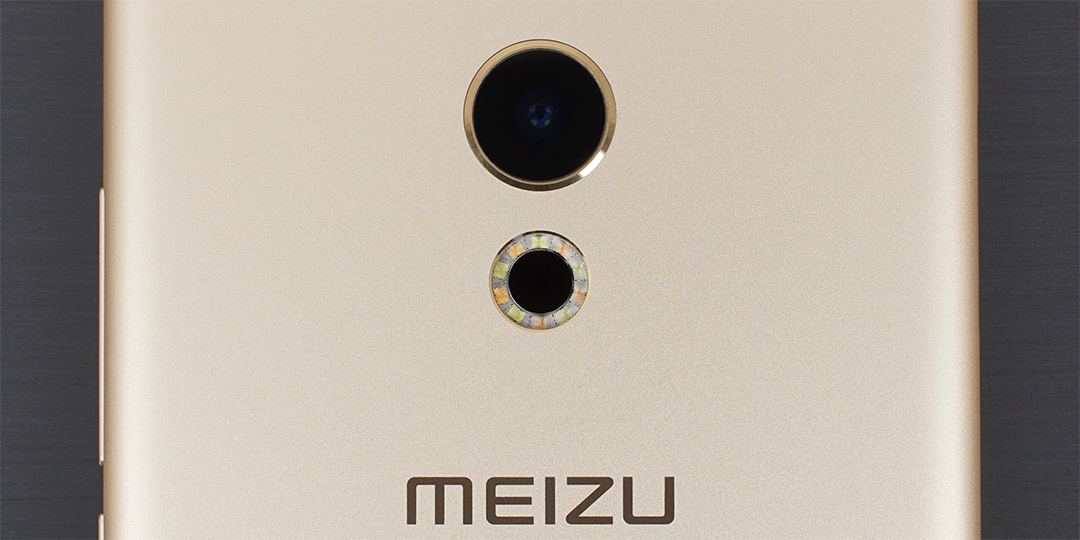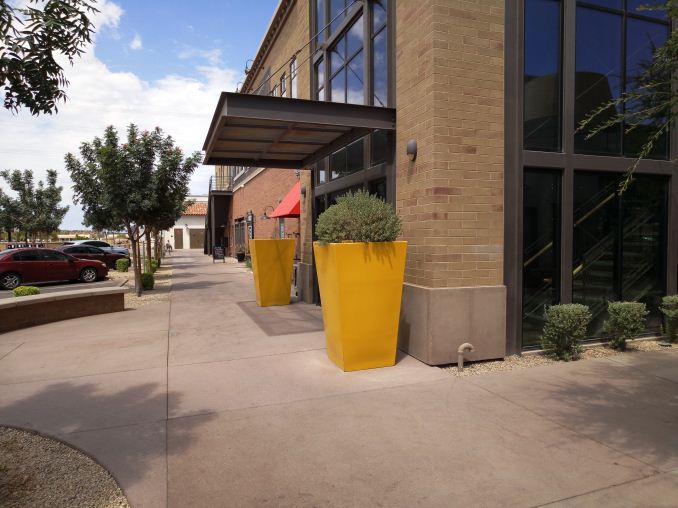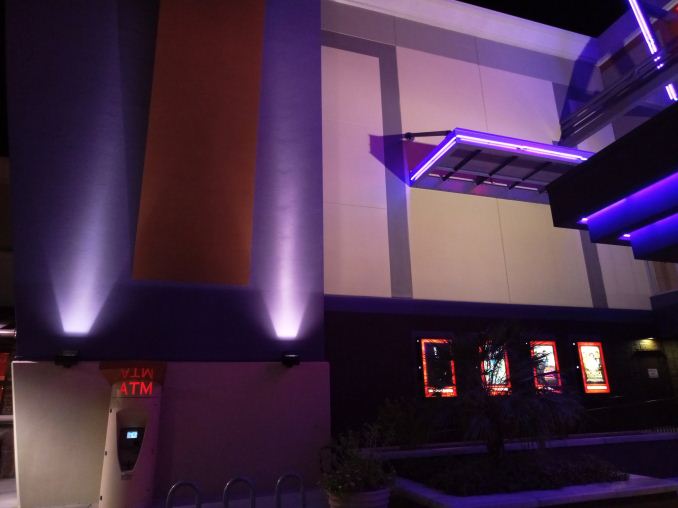The Meizu PRO 6 Review
by Matt Humrick on August 26, 2016 8:00 AM EST- Posted in
- Smartphones
- Mobile
- MediaTek
- Meizu
- PRO 6
Camera Hardware
The Meizu PRO 6 uses the same Sony IMX230 Exmor RS sensor for its rear camera as the PRO 5 that captures up to 21MP images with a 4:3 aspect ratio. This is a backside-illuminated (BSI) CMOS sensor with a stacked design that moves the transistors from the photoactive layer onto one or more separate layers. It does not have deep trench isolation (DTI) technology, however.
There’s no optical image stabilization (OIS) for the rear camera, but it does use a sophisticated hybrid autofocus (AF) system. Like the PRO 5, it combines three different AF technologies with complementary strengths. In good lighting conditions, the PRO 6 can use phase detect autofocus (PDAF) for improved speed. In low-light or low-contrast conditions, it turns to its laser AF module located in the center of the ring flash. This time-of-flight ranging module is STMicroelectronics’ second-generation VL53L0 sensor that improves operational distance to 2 meters (~6.5 feet), about 4x further than the PRO 5’s effective 0.5 meter (~1.6 feet) range. If neither of these solutions prove effective, the PRO 6 falls back to traditional contrast-based AF.
| Camera Architecture | ||
| Meizu PRO 6 | Meizu PRO 5 | |
| Front Camera: Resolution | 5MP | 5MP |
| Front Camera: Sensor | OmniVision OV5695 (1.4μm, 1/4") |
OmniVision OV5670 (1.12µm, 1/5") |
| Front Camera: Focal Length | 2.93mm (28mm equivalent) | 2.64mm (27mm equivalent) |
| Front Camera: Aperture | f/2.0 | f/2.0 |
| Rear Camera: Resolution | 21.16MP | 21.16MP |
| Rear Camera: Sensor | Sony IMX230 Exmor RS (1.12µm, 1/2.4") |
Sony IMX230 Exmor RS (1.12µm, 1/2.4") |
| Rear Camera: Focal Length | 4.03mm (23mm equivalent) | 4.73mm (27mm equivalent) |
| Rear Camera: Aperture | f/2.2 | f/2.2 |
Meizu redesigned the PRO 6’s 6-element lens system to use a shorter 23mm (35mm equivalent) focal length so it could reduce the thickness of the chassis without creating a large camera bump. A shorter focal length increases field of view (how much of a scene fits into a frame) but decreases magnification (focal lengths less than about 50mm produce images that appear smaller than what’s seen with the naked eye). The PRO 6’s focal length is a bit shorter than usual; most rear cameras fall between 26mm (Galaxy S7) and 29mm (LG G5).
Unfortunately, combining the PRO 5’s f/2.2 aperture with a shorter focal length reduces the PRO 6’s aperture area, which means less light reaching the camera sensor. The PRO 6’s aperture area is 27% smaller than the PRO 5’s, a significant reduction that will impact low-light performance. For reference, the PRO 6 also has a smaller aperture area than the Samsung Galaxy S7 (46%), Huawei P9 (20%), and even the iPhone 6s (6%). This gives the PRO 6 the smallest aperture area of any flagship phone (and even most midrange phones) that I’m aware of—a clear case of form over function.
Camera Still Image Quality
A new lens system is not the only camera difference between the PRO 6 and the PRO 5: The PRO 6 uses a different ISP, which means different software post-processing. To see what impact these changes have on image quality, we’ll compare several photos taken with the PRO 6 to the same ones taken with the PRO 5. We’ll also throw in the Samsung Galaxy S7, which uses a 12MP Sony IMX260 Exmor RS sensor with OIS, and the Huawei P9, which uses dual 12MP sensors—one color and one black and white, as additional reference points. All of these phones capture images with a 4:3 aspect ratio, and all of the images were taken using the stock camera app's Auto mode unless noted.
| Daylight Photo Comparison 1 |
In this first daylight scene, I’d say the Meizu PRO 5 actually captures the best image: exposure is perfect, colors are nicely saturated, noise is low, and white balance is very close. The Galaxy S7 and Huawei P9 also get the exposure right, but the S7’s colors are oversaturated and the P9’s white balance is too warm, giving the sky a purple tint. The PRO 6’s image is pretty good too, just not as good as the PRO 5’s. Areas in shadow appear darker and the white clouds are clipped, making them appear overexposed; however, the PRO 6’s shutter speed is almost the same as the PRO 5’s. The difference is that the PRO 6 sets ISO 3x higher, reducing dynamic range.
The PRO 6’s image also shows more noise grain in the sky than the other phones and is definitely using different noise reduction processing than the PRO 5. It’s also using a more aggressive unsharp mask filter than the PRO 5 that makes the grass and bushes look less natural. Both the Galaxy S7 and Huawei P9 also apply heavy sharpening, as indicated by the white halos around the fence, but avoid applying artifacts to the grass and foliage.
These images also show the effect of the PRO 6’s shorter focal length. Even though all of the images were taken from the exact same spot, objects in the PRO 6’s image appear farther away and its camera captures a wider field of view.
| Daylight Photo Comparison 2 |
The images in this second daylight scene show some variation in brightness and color temperature due to small differences in cloud cover, so we’ll focus on detail and post-processing. The PRO 6 captures a nicely detailed image with more texture on the sidewalk and the bricks on the building by combining a high-resolution sensor with less aggressive noise reduction. It does show more noise grain than the other phones again and shows some sharpening artifacts on the sidewalk, though. The Huawei P9 also captures a lot of detail here. Noise reduction processing wipes away some of the background texture from the Galaxy S7’s and PRO 5’s images.
Like most phones, the PRO 6 does not provide a live preview of the HDR effect. Its image capture performance is also slower than similarly priced phones. The PRO 6 takes roughly 1.0-1.5 seconds to capture a standard 21MP image and 2.5-3.0 seconds to capture HDR images at max resolution. For comparison, the PRO 5, which uses the Exynos 7420’s dual-channel ISP, takes up to 2 seconds per HDR shot, which might not sound like much of a difference, but it’s noticeable.
The good news is that the PRO 6’s HDR image quality is much better than the PRO 5’s. Where the PRO 5 just brightens the entire image, making the overexposed areas worse, the PRO 6 effectively brightens the darker areas while reducing the clipping in the brighter areas such as the clouds in the first image. If speed is not a priority, it’s probably a good idea to just leave HDR toggled on, because the PRO 6 consistently sets ISO higher than the PRO 5 and other phones to the detriment of dynamic range. In both of the pictures with HDR turned off, the PRO 6 struggles with shadow detail and clips bright highlights, a problem the PRO 5 does not have with the same camera sensor.
Color saturation also looks much better in the PRO 6’s HDR images, a vast improvement over the PRO 5’s heavily saturated, unnatural colors. There’s some odd ghosting in the tree branches in the first image, but it’s not too distracting and it does not show any noticeable purple fringing that can result from post-processing.
| Evening Photo Comparison 1 |
The Galaxy S7 captures the best image of the movie theater. It sets exposure correctly, and its colors are accurate and nicely saturated. Using the lowest ISO setting of the group (250) helps it keep image noise low while still preserving the building’s texture. It’s image also shows the highest dynamic range of the group.
Even with an 1104 ISO, the highest of the group, the PRO 6 captures the darkest image. Color is similar to the PRO 5’s image: It’s just a little too purple, although, it’s not nearly as bad as the P9’s image. Using the least amount of noise reduction processing helps the PRO 6 preserve more of the building’s texture, at least relative to the PRO 5, but does give its image the most visible noise grain of the group.
The second set of images of the grassy field dimly lit by yellow sodium lamps just shows the performance gap between the Galaxy S7’s flagship-level camera, which specifically focuses on low-light performance by including features such as a large aperture lens, OIS, and larger pixels, and a midrange-level camera system like what’s included in the PRO 6 and PRO 5.
In good lighting, the PRO 6’s camera does pretty well. Exposure and white balance are usually correct, but its images do not have as much dynamic range as the PRO 5’s, leading to clipped highlights and darker shadows. The PRO 6’s post-processing tends to create sharpening artifacts in grass, foliage, and other busy patterns, and its light use of noise-reduction preserves detail at the expense of more visible noise grain, which is most visible in low-light shots. Its HDR mode works well, creating natural looking images that look far better than the PRO 5’s, although processing speed is a bit slow.






























48 Comments
View All Comments
Shadow7037932 - Friday, August 26, 2016 - link
Never coming lol.jjj - Friday, August 26, 2016 - link
The system perf results depend more on Meizu's ROM and config not on the SoC itself,you are blaming the SoC because you haven't seen it in other devices.This device is often slower than devices with the A72s at 2.1GHz and that's entirely on Meizu.
jjj - Friday, August 26, 2016 - link
The GPU perf is off too, this device should be hitting 40FPS in T-Rex not 30.jjj - Friday, August 26, 2016 - link
Not and ideal test but look at 360 N4 (2.1GHz) vs LeEco (2.3Ghz) vs Meizu Pro 6 vs MI 5 with SD820 https://youtu.be/oDkfpnxzOMA?t=385Not only Meizu is slow but they are far more aggressive in keeping the A72s offline.
Even so your benchmarks are off.
Lodix - Sunday, August 28, 2016 - link
Which is the floating app that the guy uses to monitor se CPU ?Matt Humrick - Friday, August 26, 2016 - link
This is a product review and only shows how well Meizu implemented the SoC in this particular phone. As you said, the PRO 6’s performance depends heavily on its software configuration. I consistently (I think) said PRO 6 instead of referring to the SoC when discussing performance, and I did specifically mention the role software plays on the first page:"but this depends on how Meizu prioritizes the A72 cores. If the PRO 6 places more emphasis on reducing power consumption by placing more threads on the middle-tier A53 cluster instead of migrating them to the higher performance A72 cluster."
We would need to do further testing, and see how the X20/X25 performs in more than one phone, before we could pinpoint its true performance potential in a proper SoC deep-dive article.
jjj - Friday, August 26, 2016 - link
Later in the review to some extent but when i made the first comment (sorry for the spam,no edit) i was at "Unfortunately, Meizu’s use of the Helio X25 and its deca-core CPU does not translate into a better user experience."I do consider PCMark as very software dependent too. Check out this Meizu with just A53s http://www.futuremark.com/hardware/mobile/Meizu+m1...
And In GFXBench i think they list some kind of average https://gfxbench.com/device.jsp?benchmark=gfx40&am...
The device itself is about looks and pressure touch for a certain type of buyers.
The SoC is interesting as 2.1-2.3GHz versions are half the price of a SD820 and that's why we see it in 135$ and up phones.
Cinnabuns - Friday, August 26, 2016 - link
The exact line you quoted mentions Meizu's use of the X25, strongly hinting that Meizu is to blame for the poor SOC performance. The preceding paragraphs almost go out of their way to not mention the X25 by name. It's pretty clear from that alone that the author believes Meizu may be hampering the SOC's performance with their own poor software configuration.jjj - Friday, August 26, 2016 - link
The line i quoted blames Meizu for the SoC choice., thus the SoC. Unless you interpret the term"use " in a way you can only do after seeing this conversation. The author himself doesn't know how specific this is to Meizu.Anyway Meizu didn't had a choice. They are in conflict with Qiualcomm over how they charge for patents and never liked them much anyway while the Exynos doesn't support CDMA2000.
JoeMonco - Saturday, August 27, 2016 - link
No, you're simply going out of your way to be offended.